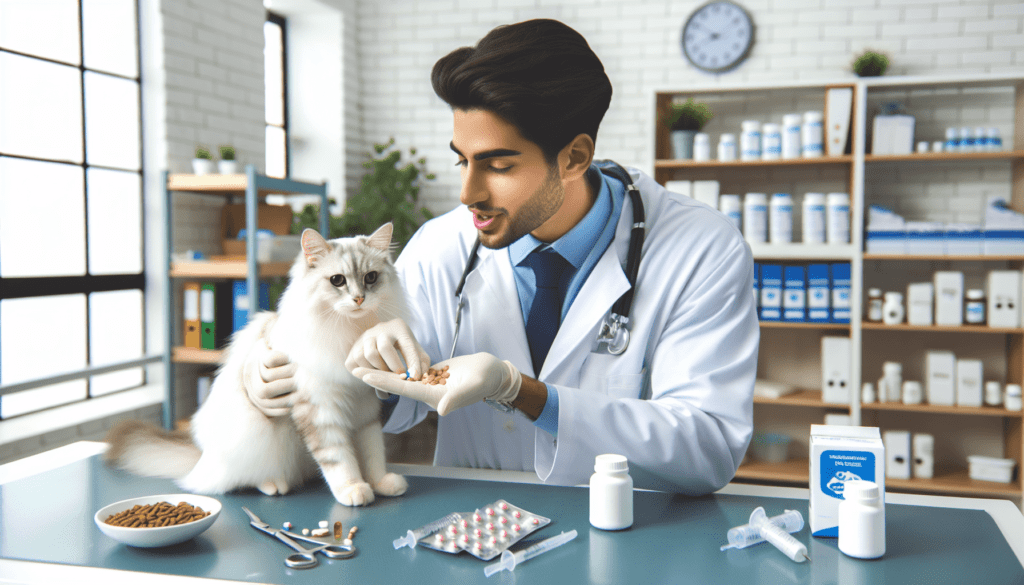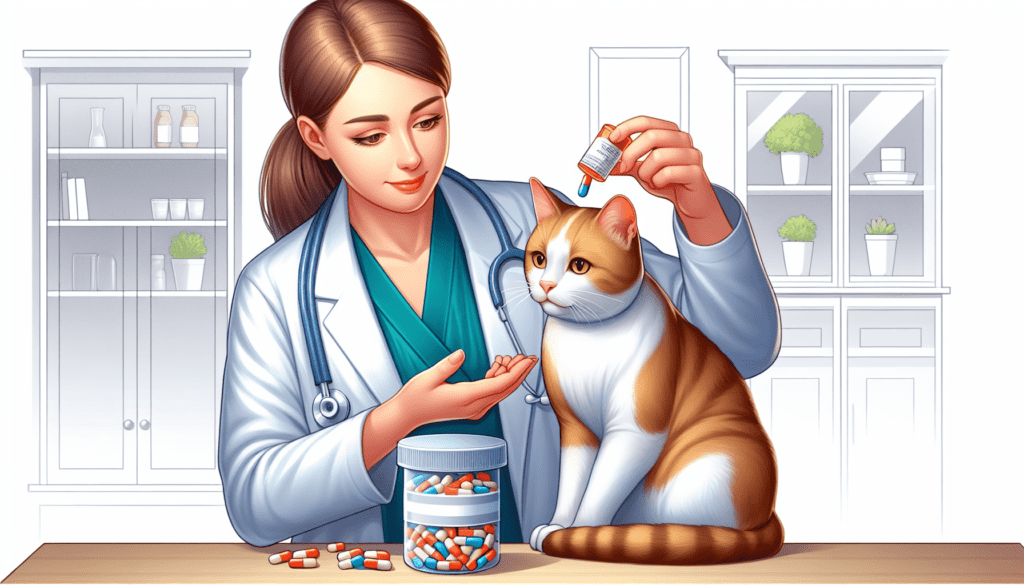If you’ve ever had to give your cat medication, you know it can be quite the challenge. From evasive maneuvers to hissing and scratching, it’s not always an easy task. But fear not, because we’re here to help! In this article, we’ll share with you ten valuable tips on how to give your cat medication without turning it into a battle. From tricks to disguise the pills to gentle techniques that will make your furry friend more cooperative, we’ve got you covered. So grab your cat, a dose of patience, and let’s get started!


Choosing the Right Medication
When it comes to giving your cat medication, it is essential to consult with your veterinarian. Veterinarians have the expertise and knowledge to assess your cat’s condition and prescribe the best medication for their needs. They will consider factors such as the cat’s age, weight, and overall health before recommending a specific medication. Your veterinarian will also inform you about any potential side effects and help you make an informed decision.
Another aspect to consider when choosing medication for your cat is the form it comes in. Medications can be available in various forms such as pills, liquids, or even injectables. The form you choose will depend on your cat’s preferences and ease of administration. Some cats may be more accepting of pills, while others may prefer liquid medication. Discuss the different options with your veterinarian to determine the most suitable form for your cat.
Preparing the Medication
Before administering medication to your cat, it is crucial to read the instructions carefully. The instructions will provide you with essential information on the correct dosage, frequency of administration, and any specific instructions for storing and handling the medication. Make sure to follow the instructions precisely to ensure your cat receives the proper dosage and treatment.
To prepare for medication administration, gather all the necessary supplies in advance. This includes any syringes, droppers, or pill crushers that may be required. Having everything ready will help streamline the process, making it easier for you and your cat.
Proper storage and handling of medication are crucial to maintain its efficacy. Some medications need to be stored in the refrigerator, while others require room temperature storage. Make sure to check the instructions or ask your veterinarian about the appropriate storage conditions. Additionally, always handle the medication with clean hands or gloves to prevent contamination.
Creating a Calm Environment
Creating a calm environment is essential to make the medication administration process less stressful for both you and your cat. Choose a quiet and comfortable space where you can administer the medication without distractions or interruptions. It can be a designated area or a familiar spot where your cat feels at ease.
Minimizing distractions is important to keep your cat focused during the administration. Turn off the TV or any loud noises and make sure there are no sudden movements or other pets present. By eliminating distractions, you can help your cat feel more relaxed and cooperative.
Using positive reinforcement techniques can also contribute to creating a calm environment. Rewarding your cat with treats or praise before and after medication administration can help build trust and make the overall experience more positive. Take your time, be patient, and offer plenty of reassurance and affection to help your cat feel secure.
Handling Techniques
Proper handling techniques can greatly facilitate the medication administration process. When approaching your cat, do so with care and confidence, as cats are sensitive to their owner’s emotions. Avoid sudden movements or actions that may startle your cat and cause them to become anxious or defensive.
The towel wrapping method can be particularly helpful in handling cats during medication administration. This technique involves wrapping a towel around your cat’s body, leaving only their head exposed. By doing so, you can secure your cat’s limbs and minimize their ability to resist while administering the medication.
Administering medication with a syringe is a common method for many liquid medications. To do this, gently hold your cat’s head and slowly dispense the medication into the side of their mouth. Be cautious not to administer the medication too quickly, as it may cause choking or discomfort.


Pill Administration
Administering pills to cats can be challenging, but with the right techniques, it can become more manageable. To begin, hold your cat firmly but gently, ensuring they are comfortable and secure. Use your non-dominant hand to hold their head and tilt it back slightly, opening their mouth.
Once the cat’s mouth is open, carefully place the pill at the back of their tongue. Gently close their mouth and hold it shut while stroking their throat to encourage swallowing. You may also give them a treat immediately afterward to help ease any discomfort and create a positive association with the medication.
Liquid Medication
Liquid medications are another common form of medication for cats. To administer liquid medication, start by measuring the correct dosage using a syringe or dropper. This ensures accuracy and helps prevent under or overdosing.
Approach your cat gently, and with the measured dosage in the syringe or dropper, slowly insert it into the side of their mouth. Administer the medication slowly, allowing your cat time to swallow. By aiming the liquid towards the side of their mouth, you can prevent them from spitting it out.
Crushing Medication
In some cases, your veterinarian may prescribe a medication in pill form that needs to be crushed before administration. Before crushing any medication, consult with your veterinarian to ensure it is safe and appropriate for your cat.
To crush pills, you can use a pill crusher or a mortar and pestle. Both methods allow you to grind the pill into a fine powder, making it easier to mix with food. After crushing the medication, mix it with a small amount of wet food, ensuring your cat consumes the entire dose.
Using Treats or Soft Food
Using treats or mixing medication with soft food can be effective strategies to encourage your cat to take their medication. You can hide the medication inside a tempting treat that your cat enjoys, ensuring they consume the medication along with the treat.
Alternatively, mixing the medication with a small amount of soft food, such as wet cat food, can help disguis the taste and texture. Ensure that your cat consumes the entire dose by monitoring their eating habits and encouraging them to finish their meal.
Alternative Delivery Methods
If traditional oral medications prove challenging for your cat, there are alternative delivery methods to explore. Injectable medications, administered by a veterinarian, can bypass the need for oral medications altogether. In some cases, transdermal medications, applied to the skin with a special medication applicator, may be an option.
For cats with specific medication needs or difficulties, compounded medications can be considered. Compounded medications are customized formulations made by a compounding pharmacy to meet specific requirements for your cat’s unique situation. Discuss these alternative delivery methods with your veterinarian to determine the best option for your cat.
Monitoring and Follow-up
After medication administration, it is important to observe your cat for any potential side effects or adverse reactions. Monitor their behavior and overall well-being, and if you notice any concerning symptoms, contact your veterinarian immediately.
Following the prescribed treatment plan is crucial to ensure your cat receives the proper dosage and duration of medication. Stick to the recommended schedule and complete the full course of treatment, even if your cat shows signs of improvement before it ends. Consistency is key to maximizing the effectiveness of the medication.
Regular vet appointments are essential to monitor your cat’s progress and make any necessary adjustments to their medication or treatment plan. These appointments allow your veterinarian to evaluate your cat’s response to the medication and address any concerns or questions you may have.
Remember, giving your cat medication can be challenging, but with patience, care, and the right techniques, it is possible to administer the medication effectively and ensure your cat receives the treatment they need. Consult with your veterinarian for guidance and support throughout the process, and always prioritize your cat’s well-being.
